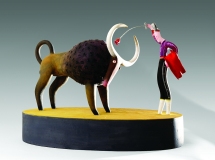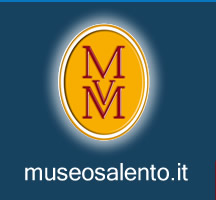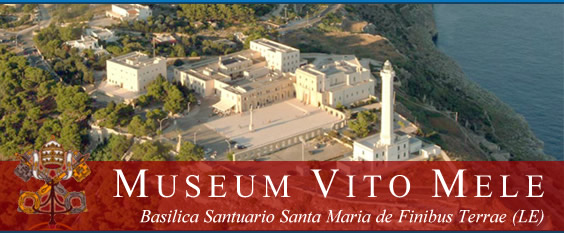|
|
| |
|
|
| |
Artisti / Artists : Museum Vito
Mele |
|
|
| |
 |
Bruno Maggio |
|
|
|
É nato a San Cesario di Lecce nel 1943,
ha seguito il corso di studi presso l’Istituto
Statale D’Arte “G. Pellegrino”
di Lecce, dove ha conseguito il diploma. Dal 1963
al 1967 si trasferì a Firenze dove frequentò
l’Accademia di Belle Arti. Sempre nel capoluogo
toscano conseguì il diploma in grafica
pubblicitaria presso la scuola “Leonardo
Cappiello” ed ebbe una gratificante esperienza
di animazione cinematografica presso lo Studio
Marchi. Nel 1976 abbandonò la grafica pubblicitaria
e si dedicò ad un’accanita ricerca
nel campo della ceramica.
Il tema dell’ironia è il sostrato
che alimenta la produzione di Bruno Maggio, scrutatore
ed artista sensibile, sempre attento alle continue
metamorfosi dell’Io. Ad un esame attento
delle sue opere si avverte il dramma della commedia
umana che si snoda sottile, frutto delle sue ricerche
psicologiche e segniche. Queste indagini, indispensabili
per delineare la tipologia dei suoi personaggi,
caricano i contenuti di profonde connotazioni
soggiacenti. Il suo palcoscenico è quello
della commedia dell’arte con le tipologie
dei
vizi e delle virtù, con gli sberleffi e
gli intrighi. È una sorta di Molière,
pronto ad intervenire, a guidare il riguardante
e a lasciarlo alla fine con il fiato sospeso.
Nella sua produzione fa da sfondo il Salento con
la sua carica di verve comica, di paura e di onnipotenza,
di sacralità e di ottimismo. Un mondo totalizzante
dove tutto partecipa del tutto. Il mondo degli
umili, quello degli animali, che a loro volta
riflettono
iconologicamente le diversità umane, come
in Fedro ed in Esopo. Tutto il suo repertorio
è legato dall’ingenuità di
una narrazione fabulistica cementata e nutrita
dall’eterna arma dell’ironia. Dal temperamento
tranquillo e schivo Bruno Maggio non ha la pretesa
di cimentarsi su temi aulici, eppure quanta aulicità
si
sprigiona dai suoi personaggi e dalle sue composizioni.
È l’aulicità dell’espressività,
avvertibile nella mimica di un volto o di un gesto.
Lo scultore diviene l’aedo silenzioso di
una tradizione che si esprime con la sola voce
della forma e del colore. Del passato ricompatta
e recupera la tradizione fittile messapica, di
Gnathia e canosina; di quest’ultima riprende
la coralità, i moniti e i sortilegi, in
una sorta di caccia alle streghe medioevaleggiante
eppure estremamente attuale. Le sue opere sono
in musei ed in collezioni pubbliche e private.
|

CORRIDA,
2004
terracotta colorata, cm. 41,5x56x37,5
|
|
|
|
| |
|
|
| |
|
 |
Bruno Maggio |
|
|
Bruno Maggio was born in 1943 in San Cesario
di Lecce and educated at the Istituto Statale
d’Arte G Pellegrino in Lecce. In 1963 he
went to the Florence Accademia di Belle Arti.
He got a diploma in commercial art from the Leonardo
Cappiello school and gained satisfying experience
of animated film at the Studio Marchi. In 1976
he gave up commercial art and devoted himself
to working in ceramics. The theme of irony underlies
and nourishes his work. He is both an observer
and a sensitive artist, aware of the continuous
metamorphosis of the id. An attentive examination
of his works reveals the drama of human comedy
unfolding itself subtly, fruit of his study of
psychology and symbolism. This investigation,
indispensable in outlining the typology of his
characters, charges the content with deep subjective
connotations. His theatre is that of the commedia
dell’arte with its archetypes of vices and
virtues, its slapstick and its intrigues. He is
a sort of Molière, ready to intervene,
to guide the observer and
leave him with his breath held. The backdrop to
his work is the Salento with its mixture of comic
verve, fear and omnipotence, its sacredness and
optimism. His is a world that is all-absorbing
and in which all are part of the whole. It is
the world of the humble and of the animals, which
in their turn reflect human diversity, as in Fedro
and Aesop. His entire repertory is linked to the
ingenuity of narrative fable made concrete and
nourished by the eternal weapon of irony. By nature
quiet and shy, Bruno Maggio has no ambition to
try his hand at high-flown themes although his
characters and compositions emanate
nobility. It is the nobility of expressiveness
that is perceptible in the mimicry of a facial
expression or of a gesture. The sculptor becomes
the silent aedo of a tradition that expresses
itself with the voice of form and colour. He recomposes
and recovers the Messapian tradition of Gnathia
and Canosina of modelling in clay. From this last
he borrows the harmony of the characters, the
warnings, and the sorcery, to carry out a sort
of medieval witch hunt that is nonetheless extremely
relevant.
His works are in museums and public and private
collections.
.
|
|
|
|
|
|
 |





